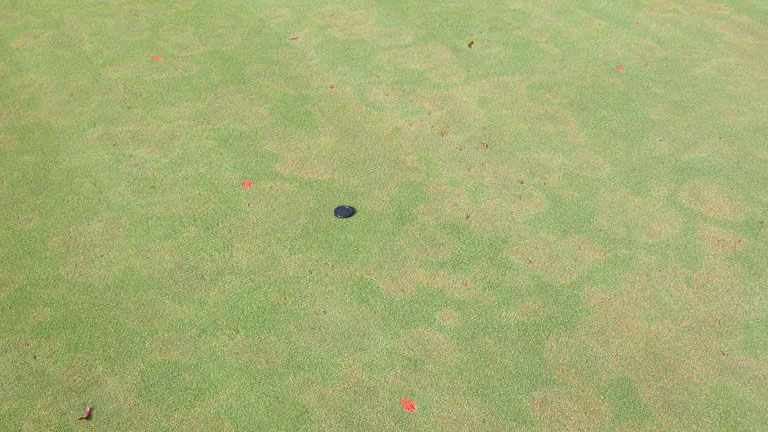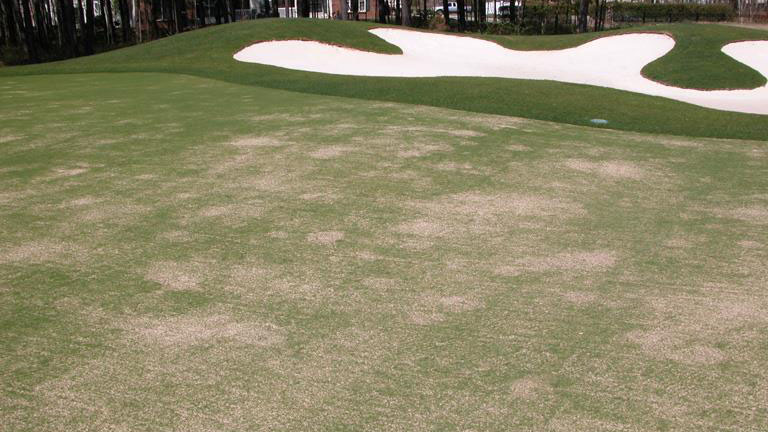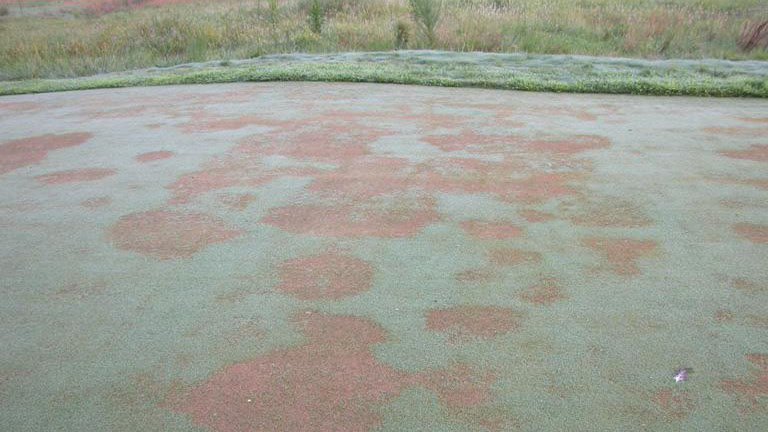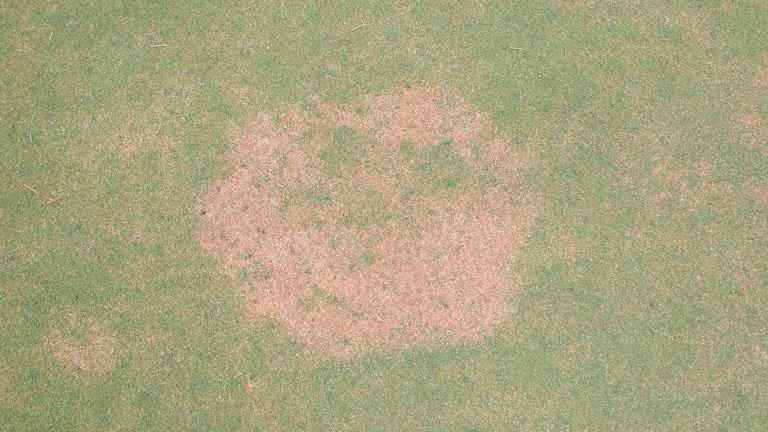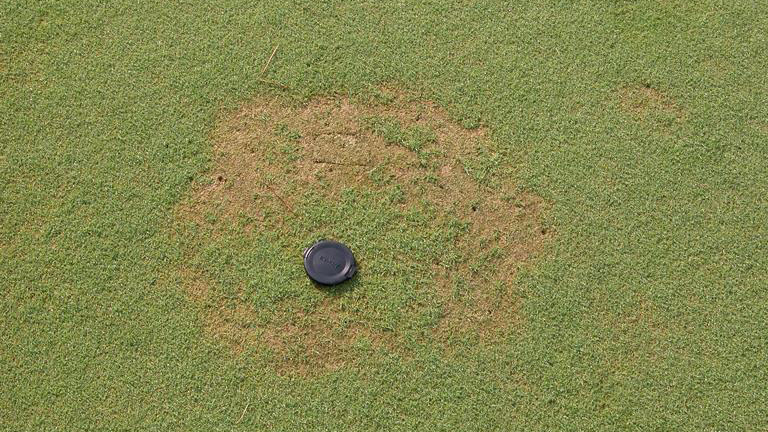Symptoms
Pythium root dysfunction is a disease of creeping bentgrass putting greens, and is most damaging to greens that were constructed within the last 10 years. The pathogen infects bentgrass roots during the fall and spring and reduces their ability to absorb water and nutrients from the soil. Symptoms may appear at any time of year, but are most severe during periods of hot and/or dry weather. Pythium root dysfunction appears in circles or irregular patches up to 2 feet in diameter that initially show signs of wilt or nutrient deficiency. As the disease progresses, affected areas turn orange and decline, eventually collapsing to the ground. Infected roots are tan in color and lack root hairs, which causes the sand to fall easily from the roots when examining a soil probe sample. Reductions in root depth may not be evident during the fall and spring, but roots infested with Pythium volutum die back rapidly when soil temperatures are above 85ºF.
Development Factors
Pythium root dysfunction infects creeping bentgrass roots in the fall, winter, and spring when mean daily soil temperatures are between 50ºF and 75ºF. Disease activity reduces the turf’s ability to absorb water and nutrition from the soil, and also leads to rapid root dieback when soil temperatures exceed 85ºF. Therefore, the appearance of Pythium root dysfunction symptoms are enhanced by low fertility, drought stress, and low soil oxygen levels. Symptoms are most common during hot weather in summer but may also appear during warm, dry conditions in fall, winter, or spring.
Cultural Control
Creeping bentgrass greens should be constructed with at least 15% organic matter by volume to provide adequate water and nutrient holding capacity. After establishment, creeping bentgrass should be fertilized with 4 to 6 lbs. N per 1,000 square feet annually. Use regular soil and tissue testing to ensure that all other nutrients are present in adequate amounts. Raise mowing heights above 0.125 in. during summer to increase photosynthesis and alleviate stress. Avoid severe drought stress by irrigating before symptoms of wilt become widespread, and supplement with syringing and hand-watering of areas that dry out more quickly. Soil surfactants increase the uniformity of soil moisture across putting greens and will assist with water management. Frequent cultivation and topdressing are needed to maximize oxygen levels in the soil. In general, 15% to 20% of the putting green surface area should be impacted by hollow-tine aerification annually, and 5,000 lbs. of topdressing should be applied per 1,000 square feet each year. Biweekly solid-tine aeration during summer will increase root survival by creating temporary channels for air and water movement through the soil profile.
Chemical Control
Standard Pythium fungicides, such as mefenoxam (Subdue Maxx), propamocarb (Banol), and fosetyl-Al (Signature) have provided poor to moderate control of Pythium root dysfunction when applied alone. The most effective fungicides in recent trials at NCSU have been picarbutrazox (Serata), cyazofamid (Segway), and fluopyram/prothioconazole/propamocarb (Resilia).
Fungicides may be used on either a curative or preventative basis for Pythium root dysfunction control. Both strategies employ the same fungicide rotation with all applications watered in immediately with 1/8 inch of post-application irrigation:
- Serata (0.6 fl oz per 1,000 square feet)
- Resilia (4 fl oz per 1,000 square feet)
- Segway (0.45 fl oz per 1,000 square feet)
Serata should be applied for preventative control every 21 to 28 days in the fall and spring when mean daily soil temperatures are between 50°F and 75°F. Curative applications should be made every 14 to 28 days based on the appearance of symptoms. In recent trials, we have not observed significant differences among QoI fungicides when used alone for Pythium root dysfunction. Regardless of which fungicide is applied, effective curative control also requires increased mowing heights and nitrogen inputs to relieve stress and allow the affected plants to heal.
* Products marked with an asterisk are not labeled for home lawn use.
| Fungicide and Formulation1 | Amount of Formulation2 | Application Interval (Days)3 | Efficacy Rating | Resistance Risk | FRAC Code4 |
| azoxystrobin (Heritage) WG TL |
0.4 2 |
21 to 28 21 to 28 |
++ | High | 11 |
| azoxystrobin + acibenzolar-S-methyl (Heritage Action)* | 0.4 | 21 to 28 | ++ | High | 11/P01 |
| cyazofamid (Segway) | 0.45 to 0.9 | 14 to 21 | +++ | High | 21 |
|
cyazofamid + azoxystrobin (Union) |
5.75 | 21 to 28 | +++ | High | 21/11 |
| fluoxastrobin (Fame) SC G |
0.27 to 0.36 1.6 to 4.6 lbs |
14 to 28 14 to 28 |
++ | High | 11 |
| fluoxastrobin + chlorothalonil (Fame C)* | 4.5 to 5.9 | 14 to 28 | ++ | High | 11/M5 |
| mefentrifluconazole + pyraclostrobin (Navicon)* | 0.85 | 14 to 28 | +++ | High | 3/11 |
| picarbutrazox (Serata) | 0.6 to 0.8 | 21 to 28 | ++++ | High | U17 |
|
pydiflumetofen + azoxystrobin + propiconazole (Posterity XT)* |
3 | 21 to 28 | ++ | High | 7/11/3 |
| pyraclostrobin (Insignia) WG SC |
0.9 0.7 |
14 to 28 14 to 28 |
++ | High | 11 |
| pyraclostrobin + boscalid (Honor)* | 1.1 | 14 to 28 | ++ | High | 11/7 |
| pyraclostrobin + fluxapyroxad (Lexicon Intrinsic) | 0.47 | 14 to 28 | +++ | High | 11/7 |
| 1 Other trade names with the same active ingredients are labeled for use on turfgrasses and can be used according to label directions. 2 Units are oz, fl oz, or lb depending on formulation. Apply fungicides in 2 to 5 gallons of water per 1,000 square feet according to label directions. Use lower rates for preventive and higher rates for curative applications. 3 Use shorter intervals when conditions are very favorable for disease. 4 Fungicide Resistance Action Committee code. Products with same code have the same mode of action and are in the same chemical class. * Products marked with an asterisk are not labeled for home lawn use. |
|||||
| Efficacy Rating ++++ = excellent control when conditions are highly favorable for disease development +++ = good control when disease pressure is high, excellent control when disease pressure is moderate ++ = good control when disease pressure is moderate, excellent control when disease pressure is low + = good control when disease pressure is low ? = not rated due to insufficient data |
|||||
| Resistance Risk Low = Rotate to different chemical class after 3-4 applications; tank mixing not necessary Medium = Rotate to different chemical class after 1-2 applications; tank-mixing with low or medium risk product recommended High = Rotate to different chemical class after EVERY application; tank-mix with low or medium risk product for EVERY application ? = not rated due to insufficient data |
|||||
Species Data
- HOST SPECIES
- creeping bentgrass
- MONTHS WITH SYMPTOMS
- all
- STAND SYMPTOMS
- FOLIAR SYMPTOMS LOCATION / SHAPE
- dieback from leaf tip
- FOLIAR SYMPTOMS COLOR
- orange, yellow
- ROOT / CROWN SYMPTOMS
- roots tan and lacking root hairs
Figure 9
- roots tan and lacking root hairs
- FUNGAL SIGNS
- none
Publication date: Nov. 15, 2017
Reviewed/Revised: Dec. 16, 2019
Recommendations for the use of agricultural chemicals are included in this publication as a convenience to the reader. The use of brand names and any mention or listing of commercial products or services in this publication does not imply endorsement by NC State University or N.C. A&T State University nor discrimination against similar products or services not mentioned. Individuals who use agricultural chemicals are responsible for ensuring that the intended use complies with current regulations and conforms to the product label. Be sure to obtain current information about usage regulations and examine a current product label before applying any chemical. For assistance, contact your local N.C. Cooperative Extension county center.
N.C. Cooperative Extension prohibits discrimination and harassment regardless of age, color, disability, family and marital status, gender identity, national origin, political beliefs, race, religion, sex (including pregnancy), sexual orientation and veteran status.

